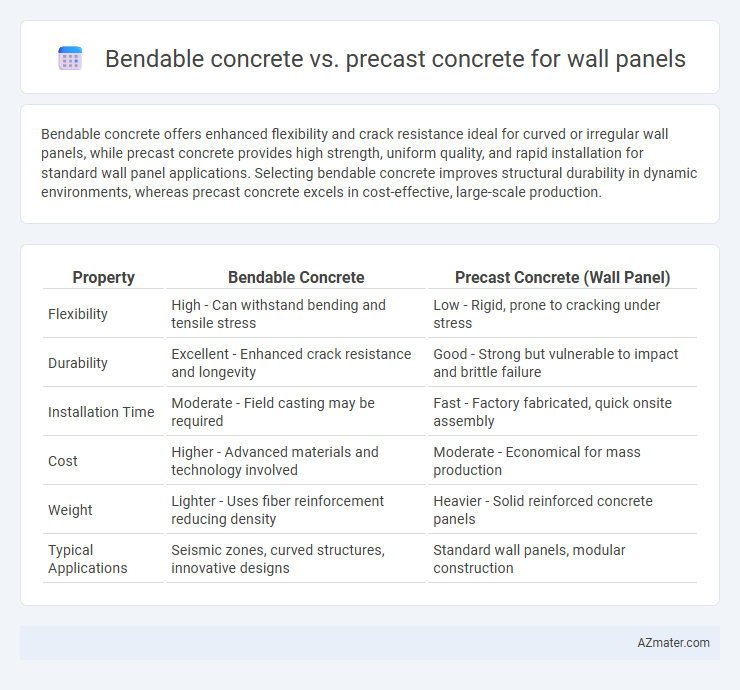Bendable concrete offers enhanced flexibility and crack resistance ideal for curved or irregular wall panels, while precast concrete provides high strength, uniform quality, and rapid installation for standard wall panel applications. Selecting bendable concrete improves structural durability in dynamic environments, whereas precast concrete excels in cost-effective, large-scale production.
Table of Comparison
| Property | Bendable Concrete | Precast Concrete (Wall Panel) |
|---|---|---|
| Flexibility | High - Can withstand bending and tensile stress | Low - Rigid, prone to cracking under stress |
| Durability | Excellent - Enhanced crack resistance and longevity | Good - Strong but vulnerable to impact and brittle failure |
| Installation Time | Moderate - Field casting may be required | Fast - Factory fabricated, quick onsite assembly |
| Cost | Higher - Advanced materials and technology involved | Moderate - Economical for mass production |
| Weight | Lighter - Uses fiber reinforcement reducing density | Heavier - Solid reinforced concrete panels |
| Typical Applications | Seismic zones, curved structures, innovative designs | Standard wall panels, modular construction |
Introduction to Bendable and Precast Concrete
Bendable concrete, also known as engineered cementitious composite (ECC), is a highly flexible material designed to withstand tensile stresses and exhibit strain-hardening behavior, making it ideal for crack-resistant and durable wall panels. Precast concrete refers to concrete components cast and cured in a controlled factory environment before being transported to the construction site, offering high-quality finishes, faster installation, and consistent strength. While precast concrete excels in modular and large-scale applications, bendable concrete introduces enhanced flexibility and durability, crucial for seismic and impact-resistant wall panels.
Composition and Material Properties
Bendable concrete for wall panels incorporates flexible fibers such as polyvinyl alcohol (PVA) or steel to enhance tensile strength and ductility, allowing the material to absorb stress without cracking. Precast concrete consists primarily of conventional Portland cement, aggregates, and steel reinforcement, optimized for uniformity and high compressive strength through controlled factory curing. The superior flexibility and crack resistance of bendable concrete contrast with the predictable dimensional stability and load-bearing capacity of precast concrete panels.
Flexibility and Structural Performance
Bendable concrete offers superior flexibility compared to precast concrete, enabling wall panels to absorb and dissipate energy from dynamic loads without cracking. Precast concrete panels provide high compressive strength and durability but are more rigid and prone to brittle failure under tensile stress or seismic activity. The enhanced ductility of bendable concrete improves structural performance in seismic zones, while precast concrete excels in uniform quality and rapid installation.
Installation Process Comparison
Bendable concrete wall panels offer enhanced flexibility during installation due to their ability to conform to curved or irregular surfaces, reducing the need for complex formwork compared to precast concrete panels. Precast concrete panels require precise casting and transportation logistics, often necessitating heavy machinery for placement, which can extend installation time and costs. The installation of bendable concrete typically involves lighter handling and on-site adjustments, resulting in faster project timelines and lower labor requirements.
Durability and Resistance to Cracking
Bendable concrete offers superior durability and enhanced resistance to cracking compared to precast concrete for wall panels due to its high tensile strength and fiber-reinforced composition. Precast concrete, while durable under compression, is more prone to brittle failure and crack propagation under tension or flexural stress. The flexibility of bendable concrete allows wall panels to withstand dynamic loads and thermal expansion, reducing maintenance and extending lifespan significantly.
Cost Implications and Economic Viability
Bendable concrete offers advantages in reduced labor costs and material waste due to its flexibility and thinner profiles, potentially lowering overall production expenses compared to precast concrete. Precast concrete wall panels, while involving higher initial manufacturing and transportation costs, provide economies of scale and consistent quality that can enhance long-term durability and reduce maintenance expenses. Evaluating project-specific factors such as structural requirements and installation complexity is crucial to determining the most economically viable option between bendable and precast concrete wall panels.
Application Scenarios in Wall Panels
Bendable concrete offers enhanced flexibility and crack resistance, making it ideal for complex, curved, or dynamic wall panel designs in architectural facades and seismic-prone regions. Precast concrete wall panels provide high strength, uniformity, and faster installation for standardized, repetitive applications such as commercial buildings and infrastructure projects. Selection depends on project-specific requirements where bendable concrete excels in innovative, adaptive structures while precast concrete suits cost-effective, large-scale production.
Sustainability and Environmental Impact
Bendable concrete offers enhanced durability and crack resistance, reducing the need for frequent repairs and lowering overall material consumption compared to traditional precast concrete wall panels. Its flexibility allows for thinner sections, minimizing resource use and contributing to a smaller carbon footprint during production and transportation. Precast concrete, while efficient for large-scale manufacturing, typically involves higher energy consumption and CO2 emissions due to its weight and standardized rigid form.
Maintenance Requirements Over Time
Bendable concrete wall panels exhibit superior crack resistance and flexibility, reducing the frequency and cost of maintenance compared to traditional precast concrete panels prone to cracking under stress. Precast concrete, while durable, often requires periodic sealing and patching to address surface cracks and potential water infiltration, leading to higher maintenance demands over time. The enhanced durability of bendable concrete minimizes repair interventions, making it a cost-effective choice for long-term structural integrity in wall panel applications.
Future Trends in Concrete Wall Panel Technology
Bendable concrete wall panels offer enhanced flexibility and crack resistance, making them ideal for dynamic architectural designs and seismic zones, while precast concrete remains favored for speed and uniform quality in large-scale projects. Future trends emphasize integrating smart sensors within both materials to monitor structural health, combined with eco-friendly cement alternatives to reduce carbon footprints. Innovations in 3D printing technology are also accelerating the customization and scalability of bendable and precast concrete panels in sustainable building practices.

Infographic: Bendable concrete vs Precast concrete for Wall panel
 azmater.com
azmater.com